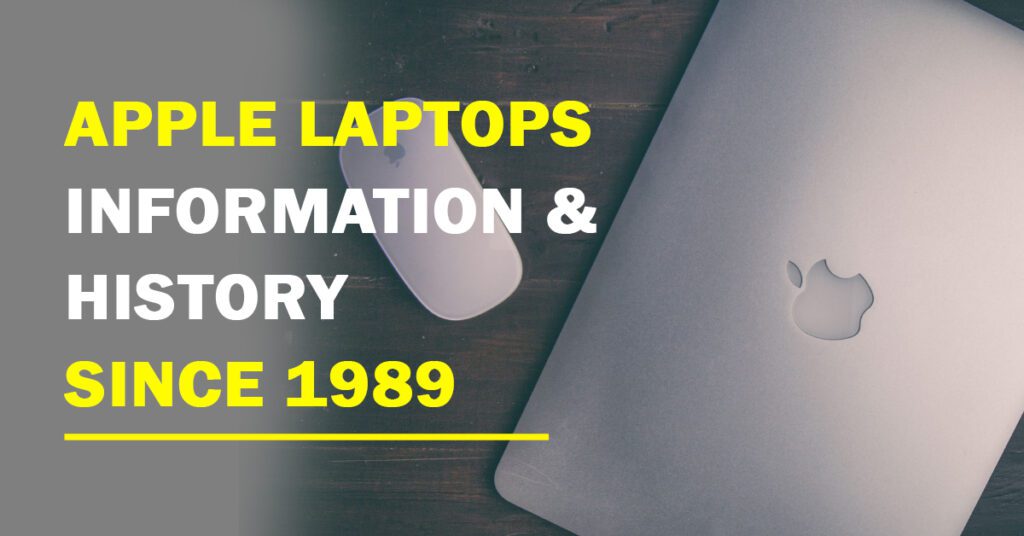
Table of Contents
ToggleAbout Apple Laptops
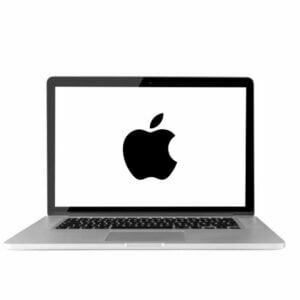
Apple laptops, commonly known as MacBooks, are popular devices for personal and professional use. MacBooks are known for their sleek design, high-quality construction, and user-friendly operating system.
There are currently three types of MacBooks available: the MacBook Air, MacBook Pro, and MacBook Pro with an M1 chip. The MacBook Air is the most portable and lightweight of the three models, while the MacBook Pro is designed for professional use and offers more power and features. The MacBook Pro with M1 chip is the newest model and uses Apple’s custom silicon, which provides improved performance, battery life, and efficiency.
MacBooks run on Apple’s proprietary operating system, macOS, which offers a user-friendly interface, seamless integration with other Apple devices, and a range of built-in software, including productivity apps and multimedia tools. MacBooks also come with built-in security features, such as Touch ID and the T2 chip, which encrypts data and helps protect against malware.
MacBooks are known for their high-quality displays, featuring Retina display technology that provides sharp and clear visuals. They also have impressive battery life, with many models offering up to 10 hours of use on a single charge.
History Of Apple Laptops
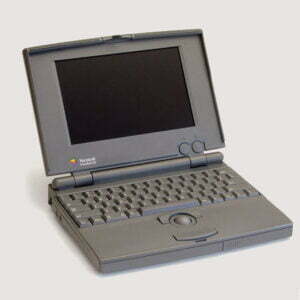
Apple Inc. is a technology company that has revolutionized the computer industry with its innovative products. Apple laptops, also known as MacBooks, have a rich history that spans over three decades.
The first Apple laptop was the Macintosh Portable, which was released in 1989. It had a 9.8-inch black and white display, a trackball for navigation, and a built-in floppy disk drive. It was not a commercial success due to its high price and limited battery life.
In 1991, Apple released the PowerBook line of laptops, which was a huge success. They were the first laptops to feature a trackpad instead of a trackball, and they also had a more ergonomic design. The PowerBook 100 was the first model in the series, and it was followed by the PowerBook Duo, which was a lightweight and compact version.
Apple continued to innovate with the release of the PowerBook G3 in 1997, which was the first laptop to feature a built-in DVD drive. The PowerBook G4, released in 2001, was the first laptop to feature a titanium casing, which made it strong and lightweight.
In 2006, Apple switched to Intel processors for its laptops, which allowed them to run Windows as well as the Mac OS. This move increased the popularity of Apple laptops among professionals and students who needed to run both operating systems.
In 2008, Apple introduced the MacBook Air, which was the thinnest laptop in the world at the time. It was designed for people who needed a lightweight and portable laptop for travel.
In 2012, Apple released the first MacBook Pro with a Retina display, which had a resolution of 2880×1800 pixels. This was a significant improvement over the standard display, which had a resolution of 1280×800 pixels.
In recent years, Apple has continued to innovate with the release of the MacBook Pro with the Touch Bar in 2016, which replaced the function keys with a touch-sensitive OLED display. The MacBook Air was also redesigned in 2018, with a thinner and lighter design and a higher-resolution display.
1989 Apple’s First Laptop
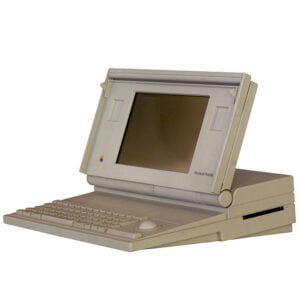
In 1989, Apple released its first laptop computer, the Macintosh Portable. It had a 9.8-inch black and white display, a trackball for navigation, and a built-in floppy disk drive. It was designed to be a portable version of the Macintosh desktop computer, but it was not a commercial success due to its high price and limited battery life. The Macintosh Portable weighed 16 pounds, which made it difficult to carry around, and it had a battery life of only 2-3 hours. Despite its shortcomings, the Macintosh Portable was an important step in the evolution of Apple’s laptop computers, and it paved the way for the more successful PowerBook line of laptops, which was introduced in 1991.
1991 Apple’s PowerBook Line Of Laptops
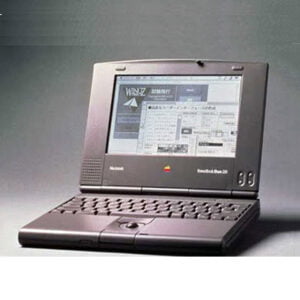
In 1991, Apple introduced its PowerBook line of laptops, which became a huge success. The PowerBook 100 was the first model in the series, and it featured a 9-inch black and white display, a trackpad for navigation, and a built-in battery that provided up to 5 hours of use. The PowerBook 100 was designed to be lightweight and portable, weighing only 5.1 pounds.
The PowerBook 140 and 170 were also introduced in 1991, and they featured a larger 10-inch black and white display and a more powerful processor. These models were slightly heavier, weighing around 6 pounds, but they were still considered to be very portable for their time.
The PowerBook line was designed to cater to the needs of professionals, students, and anyone who needed a portable computer for work or travel. The PowerBook laptops featured a more ergonomic design, with a curved keyboard that was easier to type on, and they were also the first laptops to feature a trackpad instead of a trackball for navigation.
The PowerBook line was a huge success for Apple, and it set the standard for laptop design for many years to come. The PowerBook line was followed by the PowerBook Duo, which was a lightweight and compact version of the PowerBook that was designed for even greater portability. Overall, the PowerBook line of laptops was a major milestone in the history of Apple’s laptop computers, and it helped establish Apple as a leader in the computer industry.
1997 Apple’s PowerBook G3
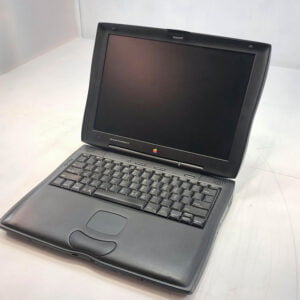
In 1997, Apple introduced the PowerBook G3, which was a major upgrade to the PowerBook line of laptops. The PowerBook G3 featured a faster processor, improved graphics, and a larger 14.1-inch color display. It was also the first laptop to feature a built-in CD-ROM drive, which was a significant improvement over the previous floppy disk drives.
The PowerBook G3 was designed to cater to the needs of professionals, and it quickly became a popular choice for graphic designers, artists, and other creative professionals. It was also the first laptop to feature a built-in Ethernet port, which made it easier to connect to the internet and other networks.
The PowerBook G3 was a major milestone in the history of Apple’s laptops, and it set the standard for high-performance laptops for many years to come. It was followed by the PowerBook G4, which was released in 2001 and was the first laptop to feature a titanium casing, which made it strong and lightweight.
The PowerBook G3 was a major step forward in the evolution of Apple’s laptops, and it helped establish Apple as a leader in the computer industry. The PowerBook G3 set the standard for high-performance laptops, and it paved the way for many of the innovations that would come in later years, such as the MacBook Air and MacBook Pro lines.
2001 Apple’s PowerBook G4
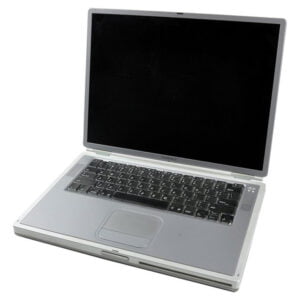
In 2001, Apple introduced the PowerBook G4, which was a major upgrade to the PowerBook line of laptops. The PowerBook G4 featured a sleek aluminum design, a faster processor, improved graphics, and a larger 15.2-inch display. It also featured a backlit keyboard, which was a significant improvement over the previous PowerBook models.
The PowerBook G4 was designed to cater to the needs of professionals, and it quickly became a popular choice for graphic designers, video editors, and other creative professionals. It was also the first laptop to feature a slot-loading optical drive, which made it easier to insert and remove CDs and DVDs.
In addition to the PowerBook G4, Apple also introduced the iBook G3 in 2001, which was a more affordable and consumer-oriented laptop. The iBook G3 featured a colorful, plastic design, a 12.1-inch display, and a built-in handle for portability. It was also the first laptop to feature built-in Wi-Fi, which made it easy to connect to wireless networks.
Both the PowerBook G4 and iBook G3 were significant releases for Apple, as they helped establish the company’s reputation for high-quality, innovative laptops. The PowerBook G4 set a new standard for performance and design, while the iBook G3 brought many advanced features to the consumer market at an affordable price point.
2006 Introduction To MacBook Pro
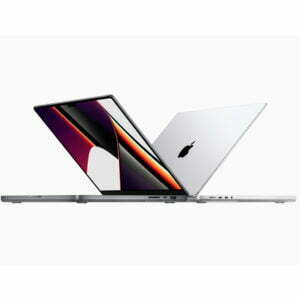
In 2006, Apple introduced several new laptop models that would go on to become classics in the company’s history. The MacBook Pro was introduced as the successor to the PowerBook G4, and it featured a sleek aluminum design, an Intel Core Duo processor, and a 15-inch display. The MacBook Pro was also the first Apple laptop to feature an integrated iSight camera, which made it easy to video chat and take pictures.
Apple also introduced the MacBook in 2006, which was a more affordable and consumer-oriented laptop. The MacBook featured a plastic design, an Intel Core Duo processor, and a 13.3-inch display. It was also the first laptop to feature a glossy display, which made colors appear more vibrant and images more lifelike.
Both the MacBook and MacBook Pro were significant releases for Apple, as they helped establish the company’s reputation for high-quality, innovative laptops. The MacBook Pro set a new standard for performance and design, while the MacBook brought many advanced features to the consumer market at an affordable price point.
In addition to the MacBook and MacBook Pro, Apple also introduced the MacBook Air in 2006. The MacBook Air was an ultra-thin and ultra-lightweight laptop that was designed for maximum portability. It featured a 13.3-inch display, an Intel Core 2 Duo processor, and a solid-state drive (SSD) instead of a traditional hard drive. The MacBook Air was a revolutionary design that inspired many imitators in the years to come, and it helped establish Apple as a leader in the laptop market.
2008 Introduction To MacBook Air
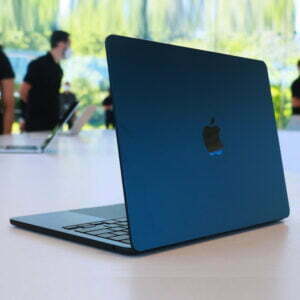
In 2008, Apple introduced several new laptops that would further cement the company’s reputation for innovation and design.
One of the most significant releases was the MacBook Air, which had first been introduced in 2006. The 2008 version of the MacBook Air featured a sleeker design, improved performance, and a larger 13.3-inch display. It was also the first laptop to feature a multi-touch trackpad, which allowed users to use gestures like pinch-to-zoom and swiping with multiple fingers.
Apple also introduced the MacBook Pro with a Retina display in 2008. This model featured a stunning 15.4-inch Retina display with a resolution of 2880 x 1800 pixels, which made text and images appear incredibly sharp and clear. It also featured a thinner and lighter design than previous MacBook Pro models, making it more portable and easier to carry.
In addition to the MacBook Air and MacBook Pro with Retina display, Apple also updated its regular MacBook line with new aluminum unibody designs. The 13-inch MacBook and MacBook Pro received a unibody design with improved durability and a sleeker look.
Overall, 2008 was a significant year for Apple’s laptops, as the company continued to push the boundaries of design and technology. The MacBook Air, MacBook Pro with Retina display, and updated MacBook models all contributed to Apple’s reputation as a leader in the laptop market.
2012 Apple MacBook
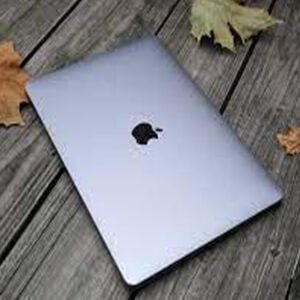
In 2012, Apple introduced several new laptops that would continue the company’s tradition of innovation and design excellence.
One of the most significant releases was the MacBook Pro with a Retina display. This model featured a stunning 15.4-inch Retina display with a resolution of 2880 x 1800 pixels, which made text and images appear incredibly sharp and clear. It also featured a thinner and lighter design than previous MacBook Pro models, making it more portable and easier to carry. The MacBook Pro with Retina display was a game changer for the laptop industry and set a new standard for high-resolution displays.
Apple also updated its regular MacBook Pro line in 2012, with a new design featuring a thinner, lighter aluminum unibody construction. The 13-inch and 15-inch MacBook Pro models were equipped with Intel Core i5 and i7 processors and high-speed Thunderbolt ports, which allowed for fast data transfer and display connections.
In addition to the MacBook Pro updates, Apple also introduced the MacBook Air with improved performance and a faster SSD. The MacBook Air also received a USB 3.0 port for faster connectivity to external devices.
Overall, 2012 was another significant year for Apple’s laptops, as the company continued to push the boundaries of design and technology. The MacBook Pro with Retina display and updated MacBook Pro and MacBook Air models helped establish Apple’s reputation as a leader in the laptop market.
Apple Laptops In 2016
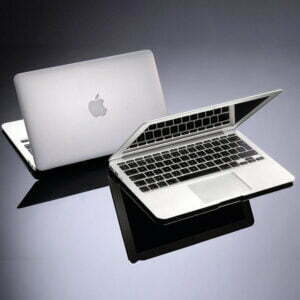
In 2016, Apple made several significant updates to its laptop lineup, including the introduction of a new MacBook Pro with Touch Bar and Touch ID.
The MacBook Pro with Touch Bar featured a new design with a thinner and lighter aluminum unibody construction. The most notable addition to this model was the Touch Bar, which replaced the function keys on the keyboard with a touch-sensitive OLED strip that displayed context-sensitive controls and shortcuts. The Touch Bar made it easier and more intuitive to interact with apps, and it was well-received by users and reviewers alike. The MacBook Pro with Touch Bar also featured Touch ID, which allowed users to unlock their laptops and make purchases with Apple Pay using their fingerprints.
Apple also updated the MacBook Air and MacBook with improved processors and graphics. The MacBook Air received a slight bump in processing power, while the MacBook received a new Intel Core m3 processor that offered better performance than the previous model.
Overall, the updates to Apple’s laptop lineup in 2016 were significant, with the introduction of the MacBook Pro with Touch Bar being the standout release. The new design and features of the MacBook Pro helped solidify Apple’s position as a leader in the laptop market, and the updates to the MacBook and MacBook Air ensured that these models remained competitive with other laptops on the market.
Best Laptops Of Apple
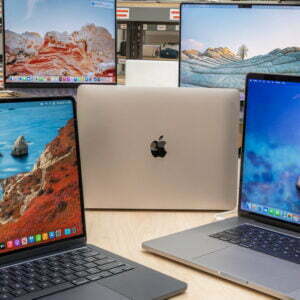
Apple is known for producing high-quality laptops with sleek designs and powerful performance. Here are some of the best laptops of Apple:
- MacBook Air: The MacBook Air is one of Apple’s most popular laptops due to its lightweight design, long battery life, and powerful performance. It features a Retina display, Touch ID, and the latest M1 chip.
- MacBook Pro: The MacBook Pro is a more powerful laptop designed for professionals who need extra performance for demanding tasks. It comes in both 13-inch and 16-inch models, with a Touch Bar and Touch ID, and the latest M1 Pro or M1 Max chip.
- MacBook: The MacBook is a highly portable laptop that is even thinner and lighter than the MacBook Air. It features a Retina display and is powered by the latest M1 chip.
All of these Apple laptops offer excellent performance and design, so the choice ultimately comes down to your specific needs and preferences.
Features Of Apple Laptops
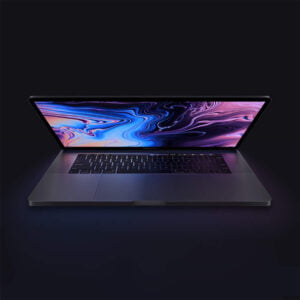
Apple laptops are known for their high-quality hardware and software, offering several features that set them apart from other laptops. Some of the best features of Apple laptops include
- macOS operating system: Apple laptops run on the macOS operating system, which is known for its user-friendly interface and seamless integration with other Apple devices. It also offers excellent security features to protect your data.
- Retina display: Apple laptops feature Retina displays, which offer high resolution and clarity, making images and text appear sharper and more vibrant.
- Touch Bar: Some Apple laptops come with a Touch Bar, a touchscreen strip located above the keyboard that provides shortcuts and quick access to frequently used tools and features.
- Touch ID: Apple laptops also come with Touch ID, a fingerprint sensor that allows for secure login and online purchases.
- M1 chip: Apple’s latest laptops are powered by the M1 chip, which offers fast and efficient performance and longer battery life.
- Built-in apps: Apple laptops come with a range of built-in apps, including Pages, Keynote, and Numbers for productivity, and iMovie and GarageBand for creative projects.
Overall, Apple laptops offer a powerful combination of hardware and software features that make them a top choice for many users, whether for work or play.
Operating System Used In Apple Laptops
Apple laptops run on the macOS operating system, which is a proprietary operating system developed by Apple Inc. macOS is based on the Unix operating system and is known for its user-friendly interface, security features, and seamless integration with other Apple devices.
MmacOS offers a variety of features and tools designed to enhance productivity and creativity, including a range of built-in apps for email, messaging, web browsing, and more. It also offers features like Siri, the digital voice assistant, and Time Machine, a backup and restores tool for your data.
The latest version of macOS is macOS Monterey, which was released in 2021. macOS Monterey offers several new features, including a redesigned Safari browser, enhanced privacy features, and improved support for working across multiple devices.
Overall, macOS is a powerful and user-friendly operating system that is optimized for use on Apple’s laptops and desktops, offering seamless integration with other Apple devices and a range of productivity and creativity tools.

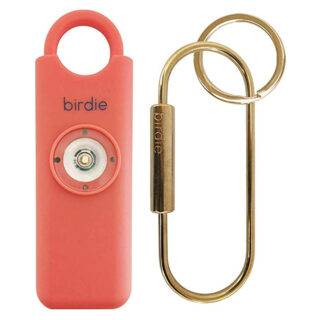
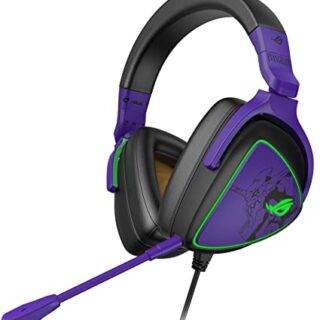

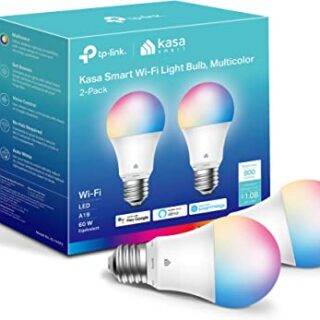


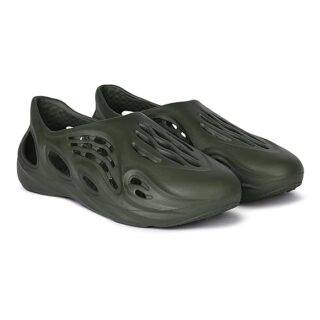
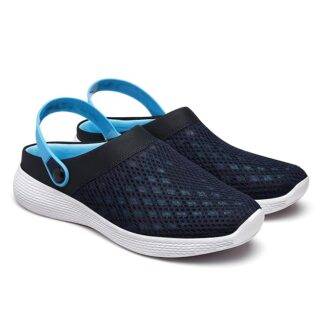

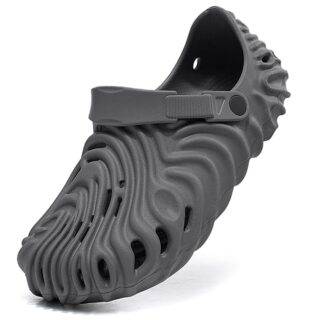
Leave a Reply